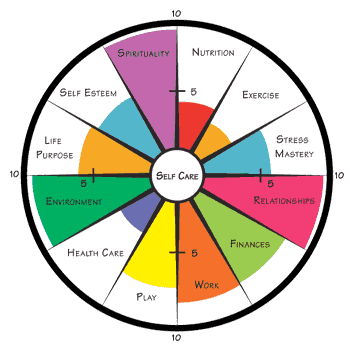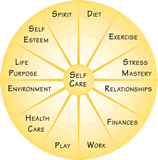Circle
of Life Health and Wellness Coaching Process
How The Circle of Life Self-Assessment
Process Worked for Kate

This example will give you a sense of how the Circle of Life works.
Kate is in a 12 week Circle of Life program hosted by her local Arthritis
Foundation. The group meets every Thursday from 9:00-10:30 a.m. and
there are 11 others in the group. Kate's arthritis is beginning to cause
increased discomfort and limitations in her life. It is impacting her
work, particularly when her pain is distracting. She doesn't like the
side effects of the pain medication and yet her condition is worsening.
STEP 1
First Kate evaluates her situation and satisfaction with life through
self-inquiry using the graphical Circle assessment form. The self-inquiry
process revealed Kate's greatest strengths and her most deficient areas.
STEP 2
Each participant in Kate's support group shared out loud one of their
strengths. Kate's area of greatest strength was in the spirituality
and intuition aspect of her life. She felt rich in her spiritual life
and knew that could help provide inner power to support her to change
in her weaker areas.
STEP 3
Kate decided to give her attention to two of her deficient areas, which
were exercise and nutrition. She would begin with exercise, because
her support group decided that they all wanted to focus on exercise
also.
STEP 4
Next she turned to the exercise section of the manual, read through
the self-inquiry questionnaire and jotted down her responses.
STEP 5
The group participants each shared ideas, information, testimony and
referrals pertaining to the topic of exercise. From the self-inquiry
questions and from the group sharing, Kate began to formulate a goal
and some appropriate action steps to take. She turned to the Strengths,
Goal, Challenge, Action sheet and filled it in.
STEP 6
She then turned to the weekly schedule and wrote down the action steps
she wanted to take for the following week. She also filled in the Living
a Life of Health, Joy and Inner Peace form.
STEP 7
Kate shared her goal, challenge, affirmation and action steps out loud
to the group and to the facilitator for accountability and support.
STEP 8
In the next meeting participants reviewed their goals and action
steps. The facilitator went around to each person asking them to share
the successes of taking their action steps or share what they learned
from the process. Kate took one action step out of the four she committed
to. The facilitator asked her questions about what she experienced or
learned about the size of her action steps, scheduling, challenges etc.
Kate realized she tried to do too much, which set her up for overwhelm
and failure.
STEP 9
Through the group sharing, the facilitator's questions and her own learning,
she reset her action steps to be smaller and more realistic. She originally
set her goal for exercising one hour 5 times a week. She adjusted her
action steps by changing to a more realistic program. She decided to
start easier and slower which was to do 15 minutes of appropriate exercise
5 days a week. She would increase a little bit each week until she reached
her new goal of 45 minutes every other day and 20 minutes on alternate
days.
STEP 10
After four weeks of the Circle of Life program, Kate and her group re-evaluated
using the Circle self-inquiry assessment. Her scores increased from
two up to six in exercise and from two to six in diet, but she was still
deficient in self-care. After four weeks Kate had already begun to experience
more mobility, and her pain diminished somewhat without needing additional
medication. This naturally gave her more self-confidence and comfort
in her personal and work life. She and the group continued the process
and she now began to study and implement self-care methods.
After 12 weeks, Kate had met her two original goals which were to
have more mobility and less pain. Through the process of clarifying
her intention and taking reasonable, consistent steps she found that
the power for healing was within her own control and that she could
create positive life outcomes. The process was so life changing that
she wanted to continue progressing. She and another member of the group
continued, on a weekly basis, to support each other using the Circle of Life method.
The Circle of Life Health and Wellness Coaching process is a best practice lifestyle coaching method. Its six phases maximize accountability and support continuous improvement for work-life balance, stress management, better health, and peace of mind.
Phase 1 -- Assessment and Self-Inquiry
Phase 2 -- Readiness for
Change
Phase 3 -- Design Change with Intentions, Goals, Challenges,
Affirmations, Actions and Accountability
Phase 4 -- Plan Actions
Phase 5 -- Take Action and Access Resources
Phase 6 -- Re-evaluation, Course Correction
and Accountability
|
Health
Coaching Certification | Life Skill Coaching | Lifestyle Coaching | Personal Coaching Personal Health Coach | Personal Health Coaching | Personal Wellness Coach | Personal Wellness Coaching | Coaching Certification | Health & Wellness Coach Certification Training | Wellness Coach Training
|
